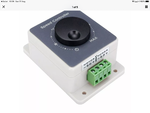Our Alde system's in-line circulating pump is not one of their products, but sourced by Hymer from elsewhere. I have not a clue if it is brushed or brushless, there are no telltale brush holders, nor meaningful markings.
So basically, I don't know its technology, but from its tone know it runs at about the same speed, that only changing slightly for a few seconds as the fluid speed accelerates from static up to running rate.
Not knowing the technology, nor much about DC motor technology myself, can I quiz the more knowledgeable, if it is still likely to be safely suited for speed variation control with the PWM based devices John has identified? If it is indeed brushless as I suspect, with a preset speed via PWM inbuilt, will I do harm? The slight note change could be no more than fluid flow generated tones, for all I know.
It can sound irritatingly too fast on nights I am sensitive to that, and it would be nice to explore if adequate thermal performance could still be achieved with it set to run slower; it is not that these days we push the performance in bitterly cold weather; we stay at home.
Any DC motor expertise out there, please?


